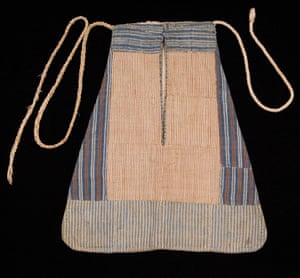
“Mistrust all enterprises that require new clothes,” says EM Forster in A Room With a View, adapting a quote from Henry David Thoreau. What a spoilsport. Because surely one of the best bits about starting a new job, getting a dog or even taking up sky-diving is that it gives you permission to fashion yourself in a slightly different way. With the acquisition of new and unusual kit comes the chance to become someone fresher, sexier or, at the very least, someone who is prepared to give yellow a go.
The reason we are so desperate to buy or borrow new clothes, says the academic and broadcaster Shahidha Bari in her clever, subtle book, is because they appear to bestow on us a charm and intellect that we can’t quite muster for ourselves. Yet the moment we acquire that new coat or those new trousers, we realise that nothing much has changed at all. For no matter how fancy we look on the surface, underneath we still come with metaphorical trailing threads and odd socks. “Dressing is so hard,” Bari writes. “It is astonishing that we ever find the courage to keep trying as we do every day.”
Although her writing is critically informed – Foucault, Deleuze, Cixous and Irigaray all rock up here to chat about schmutter – her tone is insistently personal, intimate even. Between her main chapters she drops in lyrical accounts of her own encounters with specific items of clothing. She tells us about mending a dress for a college friend who has since died, or the first time she wore spiked shoes as a schoolgirl and found herself running like the wind. Other passages are determinedly oblique, as when she buys little girls’ dresses the colour of buttercream yet makes no mention of who they are for. Her future children, her past self? The withholding is deliberate since Bari wants us to think not so much about what clothes say as how they make us feel. Take the suit. The one that she has in mind is worn by Cary Grant in North by Northwest (1959). According to a panel of fashion journalists and stylists convened by GQ in 2006, this suit is “the best in film history and the most influential on men’s style”. Designed by Grant’s Savile Row tailor, Kilgour, French and Stanley, it is neither exactly blue nor grey, and combines a ventless jacket with high-waisted, forward pleated trousers. It is a suit (or suits – during the five month shoot Grant got through eight replicas, since hanging from Mount Rushmore by your fingertips involves a certain wear and tear) that is simultaneously authoritative and insouciant.

Although the appeal of the suit is that it doesn’t look as if it’s trying too hard, Bari is convinced that beneath that sheeny worsted surface it is doing important work. She discusses Grant’s early years in Bristol at the beginning of the 20th century where, as Archibald Leach, he was abandoned by his father who turns out to have been a tailor’s cutter. Could the suit, a form of clothing with which Grant is permanently associated, be both a defence against and a triumphant reworking of early childhood trauma? “A suit rises to the occasion in these circumstances,” Bari explains. “It is capable of dignified deception, precisely because it seems, on the surface … [to keep] unruly feelings at bay.”
She is good on dresses too. By rights, of course, they have no business being in any modern woman’s wardrobe. Nearly a hundred years after it became acceptable for “advanced” females to wear “divided skirts” on the tennis court, why would anyone voluntarily shimmy themselves into a garment designed to cling to one’s body while simultaneously restricting its movement (cycling in a dress today still feels like a risky business)? Bari is particularly good on how a dress looks while on a hanger – like a second skin waiting for flesh and blood to make it live. It is this sense of the dress as an alternative self that makes it so potent, far more charged, say, than a well-cut pair of trousers or a merino jumper: “This dress – not a poem, not a painting but a dress – is something, maybe even all things, that we are not.” Which is why it is the item most likely to be languishing, unworn, at the back of the wardrobe, waiting for the moment when we feel good enough – thin enough, feminine enough, just enough enough – to put it on and step out as someone improved and approved.
Dresses aren’t always about lack or reproach. In a particularly luscious section, Bari shows us women having fun with frocks. In a 16th-century Dutch tapestry, now in the V&A, the figures of the three female Fates are stitched in the most gorgeous red, blue and gold thread. Each fold of their plush skirts seems to promise extra supplies of dense and complex satisfaction. Nothing odd about this you might think – global art is flush with gorgeously dressed girls flaunting their access to fabric. But the point here is that Clotho, Lachesis and Atropos are usually rendered as badly dressed old crones, responsible for producing the threads that other, luckier, people wear. They are the original “spinsters”, a jibe that has historically disclosed anxiety around unmarried women and their economic and sexual self-sufficiency. Here, though, the three Fates are in their best dresses and seem to be enjoying every moment of it. It takes a while to notice that at their feet, quite unregarded, lies another woman. Bari tells us that this drably clothed figure is Chastity, and that the three gorgeously attired Fates appear to have trampled her into the ground.

In her final chapter Bari includes a short section of the role of the pocket in the psychology of getting dressed. Barbara Burman and Ariane Fennetaux have written a whole book on the subject. Their pockets, though, are not the modern kind, sewn into the seams of ready-made clothes. Rather, they are the soft, detachable pouches that women used to tie around their waists and hide under their skirts, reaching for them through discreet openings in their petticoats and dresses as required. What particularly interests Burman and Fennetaux is the way in which women of all classes have historically used these tie-on pockets as a supplementary body part to help them negotiate their way through a world that was not built to suit them.
Crammed into a woman’s pocket was everything she might need to keep her going for the day, from a snack to a tract from the New Testament. It was also a way of carrying precious cargo safely. Some of the strangest things the authors came across that were stowed away in pockets include two live ducks, the afterbirth of an illegitimate baby and a pocket microscope. Tradeswomen of all sorts, from pedlars to prostitutes, were most likely to stuff theirs with bank notes, which is why when Lucy Locket lost her pocket it was worth a surprised posterity noting that “there was not a penny in it”.
Pockets were precious. Georgiana, Duchess of Devonshire, ordered hers to be made of finest silk. Middle-class girls effortfully cross-stitched theirs, turning the whole experience into a lesson in precision and patience. Working-class women, meanwhile, patched and darned their pockets relentlessly with sturdy fabric saved from somewhere else in the household’s material economy.
The proximity of pockets to the pelvic area inevitably gave them a seamy side – hence the extra layer of salacious meaning in the Lucy Locket nursery rhyme. However, there were some pitiable consequences too. Burman and Fennetaux tell the story of Annie Chapman, one of the women killed by Jack the Ripper in the autumn of 1888. As a semi-itinerant worker, scrabbling a difficult living, Chapman’s pocket was her most valuable possession. The fact that she was still using a tie-on pocket, rather than a new fangled handbag, is testimony to the fact that for vulnerable women living in precarious circumstances, this was still the best way of holding on to your worldly goods.
In the early hours of 8 September, Chapman’s mutilated body was found slumped in a yard. Particularly chilling was the fact that her pocket had also been “torn down the front and also at the side” by the murderer, who clearly saw it as a proxy for the woman’s sexual parts. Out of this ritually disembowelled pocket spilled Chapman’s best treasures: an envelope, pills, a small comb and a piece of coarse muslin that she had been hoping to pawn or sell.
• Dressed: The Secret Life of Clothes is published by Jonathan Cape (£25). The Pocket: A Hidden History of Women’s Lives, 1660-1900 is published by Yale (£35). To order a copy of either go to guardianbookshop.com or call 0330 333 6846. Free UK p&p over £15, online orders only. Phone orders min p&p of £1.99.
No comments:
Post a Comment